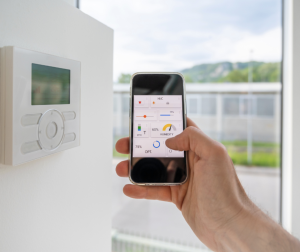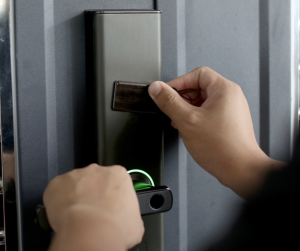The future of homes is already here.
As with all industries, technology and digitization have brought about a revolution in real estate. The term “smart home” refers to a convenient home setup, where appliances and other devices can be automatically controlled remotely from anywhere with a WiFi-connected mobile device or other networked device. They allow the homeowner to remotely control home functions such as security access, temperature, lighting, and the entertainment system.
At Alfareal, we have decided to adopt this innovative vision and bet on intelligent Coliving projects, also known as Smart Colivings. The role of AI and interactivity in creating modern and efficient residential environments is growing over time, and such growth rates are attractive as an investment. In upcoming real estate projects, the focus will be on harnessing technology to improve the quality of life for residents and foster greater connectivity with a focus on innovation.
In this article, we will talk about how home automation and the Internet of Things (IoT) have changed how we live and interact with our homes.

What is a smart home?
In an increasingly interconnected world, interactivity and artificial intelligence are essential to turn our homes into true smart homes. These future homes go beyond the conventional, and an artificial emotional system powered by devices like Alexa, smart lights, gadgets, and smart accessories is changing the way we live and experience the home environment.
Smart Coliving projects, powered by home automation and modern technology, are an innovative way of living in a community. These initiatives aim to integrate smart devices and systems into every corner of the house so that residents can use advanced and useful functionalities. Smart homes in Colivings become a technological ecosystem designed to improve the quality of life for its inhabitants, including voice commands to control lights and home temperature, manage security, and access interconnected services.
Home automation is an important part of smart homes and its main purpose is to control various aspects of the home through the integration of smart technology. In this way, greater comfort, energy efficiency and home security are achieved, as well as a personalized experience that adapts to the needs and preferences of each resident.
What is a smart home using IoT technology like?
The key components of a smart home are interactivity and artificial intelligence. The integration of devices like Amazon’s virtual assistant Alexa is a case in point, as are other competitors from Google Assistant to Apple Siri. From performing scheduled household tasks to turning smart lights on and off, these devices let you control a variety of functions around the home. A smart home can have lights turn on or off automatically based on the time of day or user preference.
There are other smart devices and accessories. Home automation systems, such as the Google Home Kit, allow the user to control and monitor various aspects of their home, such as security, lighting, and climate control. These devices offer a personalized experience by learning and adapting to user preferences.

What are the main advantages of automating a house?
The main advantage of automating a house is the comfort and convenience it provides. With a voice command or a phone app, a smart home can take control of various tasks. Home automation has the potential to increase energy efficiency by controlling the amount of electricity used and decreasing the waste of resources. In addition, by incorporating surveillance and alarm systems that can be monitored in real time, it improves home security.
With a wide range of smart security systems and devices that help safeguard our home and give residents peace of mind, home automation has revolutionized the way we protect our homes. Surveillance cameras are integrated into home automation systems and monitor both the interior and exterior of the property in real time. Many cameras have continuous or motion detection recording, providing visual evidence in the event of an incident.
Smart locks are another device used in home automation to increase security. Either through an application on the phone or through voice commands, these locks allow you to control access to the home remotely. Smart locks allow you to keep a detailed record of access, receive notifications about entry and exit activities and grant temporary access to trusted people.
There are several companies that specialize in the production of electronic devices for the home. For example, Layla Electric develops technology solutions that improve the daily lives of tenants and save costs for homeowners. One of its featured products is its line of smart home appliances. These devices are intended to provide comfort, energy efficiency and security in the domestic environment. Some examples of these devices are smart plugs, controllable LED bulbs, security systems, and surveillance cameras.

Smart Colivings: the fusion of technology and shared spaces
Each area of a smart Coliving has technology that facilitates a variety of tasks and improves the living experience. For example, smart systems control access and ensure residents are safe and easy to access, while automated systems streamline the management of shared services like laundry rooms and common rooms. These technological advances encourage interactivity and comfort, creating an innovative and functional environment for people who live together.
The emotional dimension is also important. Technology and artificial intelligence make it possible to adapt the home experience to the preferences and needs of each resident. Devices like smart lighting and background music can create cozy and relaxing environments, which also helps create an emotionally rewarding environment.
Conclusion
Home automation and smart Coliving technology are expected to continue to advance in the future. New technological advances promise to improve interactivity and convenience. For example, more advanced smart devices, more advanced AI systems, and technologies such as virtual and augmented reality are expected to be integrated to enhance the resident experience. These advances will have a significant impact on the way we live and share spaces, offering a smarter, more efficient Coliving environment adapted to our needs.
At Alfareal, we are implementing smart and sustainable Coliving projects. If you are interested in participating in innovative solutions that improve the living and coexistence experience, contact us.
Sources
- Statista
- Trade
- Investopedia

